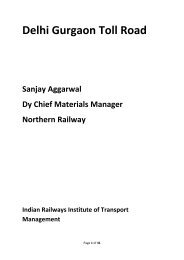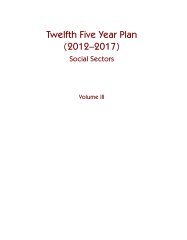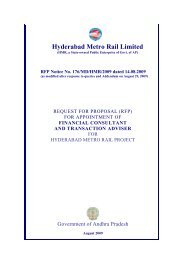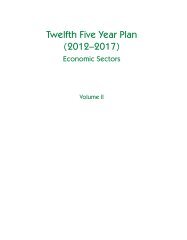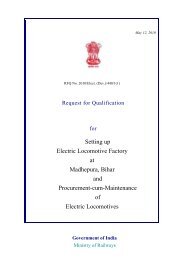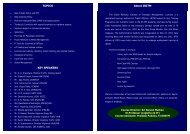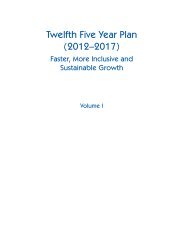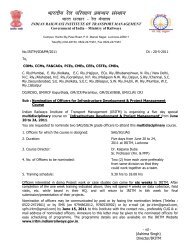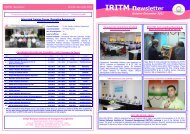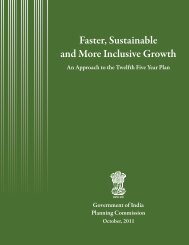Vision 2020 - Transportation Research Group of India
Vision 2020 - Transportation Research Group of India
Vision 2020 - Transportation Research Group of India
Create successful ePaper yourself
Turn your PDF publications into a flip-book with our unique Google optimized e-Paper software.
Government <strong>of</strong> <strong>India</strong><br />
Ministry <strong>of</strong> Railways<br />
(Railway Board)<br />
2.1.2 Railway traffic growth vis-à-vis GDP<br />
Period<br />
Table-1: GDP growth vis-à-vis growth in Railway Traffic<br />
(Figures in %)<br />
Average GDP<br />
growth<br />
Potential for growth<br />
<strong>of</strong> Railway traffic @<br />
Average growth in<br />
freight traffic <strong>of</strong><br />
Average growth<br />
in originating<br />
elasticity <strong>of</strong> transport railways passengers<br />
<strong>of</strong> 1.25<br />
1991-92- 5.6 7 3.9 2.4<br />
2001-02<br />
2002-03- 7.9 9.9 7.2 4.6*<br />
2008-09<br />
Note: 1.Based on Economic Survey, 2008-09 and Ministry <strong>of</strong> Railway's data on Railway traffic growth.<br />
*This includes an average growth <strong>of</strong> 7% in non-suburban and 3% in sub-urban segments. Growth <strong>of</strong> Passenger Kilometres<br />
(PKMs) has been more impressive at 9.7% in the recent period (2004-2005 - 2008-2009).<br />
In recent years, the performance <strong>of</strong> the railways has exhibited a marked departure from the earlier long-term<br />
trend <strong>of</strong> trailing GDP growth by a large margin (Table-1 above). While the upward shift in the trend <strong>of</strong> traffic growth<br />
is unmistakable, the figures in table also reveal the extent <strong>of</strong> underachievement vis-à-vis the potential. Further,<br />
the improved results are attributed to the certain operational initiatives such as flexible tariffs and optimization <strong>of</strong><br />
the loading/carrying capacity <strong>of</strong> rolling- stock, as well as efficiency <strong>of</strong> use <strong>of</strong> asset, expansion <strong>of</strong> capacity in<br />
passenger services. While these have played a useful role, a completely different strategic approach would<br />
be required to reap the full potential and achieve a quantum jump in growth.<br />
This document seeks to prepare a road-map for <strong>India</strong>n Railways to take the fullest advantage <strong>of</strong> the<br />
opportunities unfolding in the economy so that it is able to expand and grow consistently at the rate <strong>of</strong><br />
10% p.a. in line with the expected growth <strong>of</strong> our GDP at 9% per annum.<br />
2.1.3 Transport landscape for the future: Competition<br />
(a)<br />
Road Transport<br />
Railways face stiff competition from road transport in both freight and passenger businesses and from aviation<br />
sector in respect <strong>of</strong> the premium-class passenger business segment. Given the massive scale <strong>of</strong> expansion <strong>of</strong><br />
the National Highway network, build-up <strong>of</strong> huge capacity in the highly competitive trucking industry and entry <strong>of</strong><br />
modern multi-axle commercial vehicles, competition from road carriers will intensify. However, Railways score<br />
over other competing modes by virtue <strong>of</strong> the minimal impact on environment and efficiency <strong>of</strong> land use. Given the<br />
density <strong>of</strong> population in our country and the pace <strong>of</strong> urbanization, road networks will face severe congestion. The<br />
4




